One of the most frequently asked questions from those joining our winter courses is: What if there is no snow? Although we can’t control the weather, we can almost guarantee there will be snow—especially on the high peaks during winter and early spring. However, for those still concerned, let us put your worries to rest.
The Cairngorms are home to Britain’s most permanent snow beds, some of which persist well into July or even early August. The high altitude and vast plateau of the Cairngorms make them a natural snow trap. Even in milder winters, the unique topography and wind patterns often ensure that snow is captured and retained in key areas. According to a study by the Royal Meteorological Society, the Cairngorm plateau experiences snow coverage for an average of 76 days per year, making it one of the most reliable locations for snow in the UK.
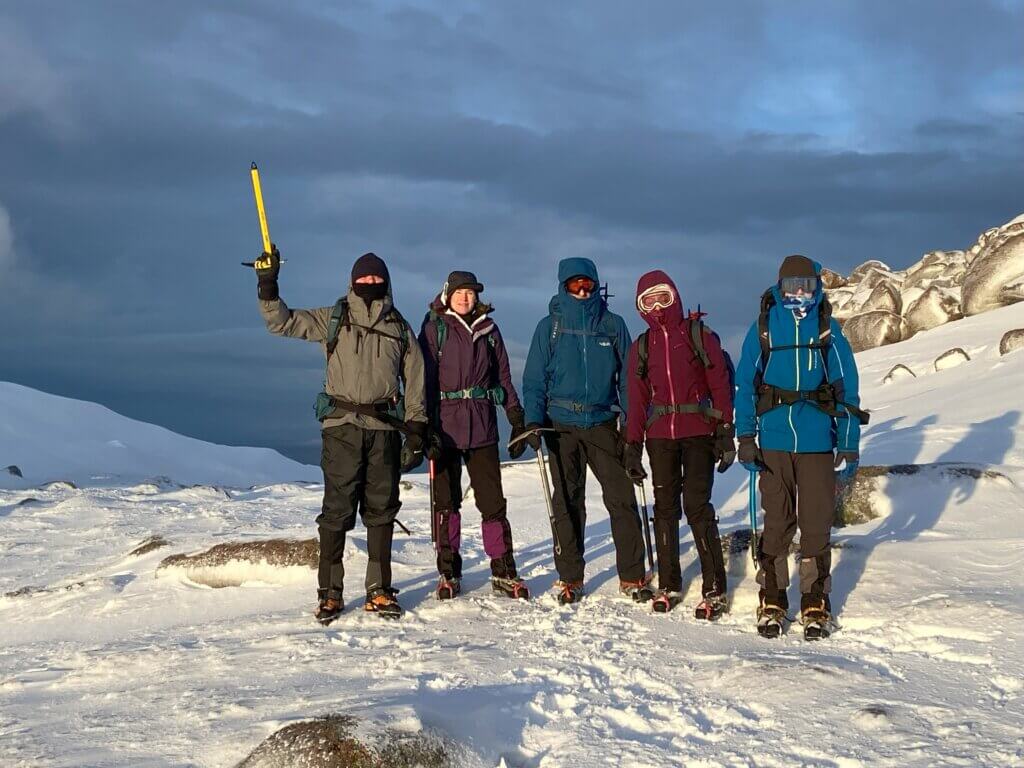
If, for some reason, the winter is unusually mild and snowfall is limited, it’s not the end of the world. Winter Skill courses with Scot Mountain Holidays are designed with flexibility in mind. Snow is just one of three critical factors that influence the course—the other two being wind (which facilitates snow drifting) and the expansive Cairngorm plateau (which helps to capture and hold snow).
Even if snow levels are lower, the skills taught during our courses remain relevant. In fact, hard, icy snow that forms after a thaw and subsequent freeze is often ideal for teaching crampon techniques. Fresh snow, while beautiful, doesn’t always add additional value to winter skills training.
In the 25 winter seasons that Scot Mountain Holidays has been running Winter Skills courses and hiking holidays, no course has ever been cancelled due to a lack of snow. This incredible track record highlights the reliability of the Cairngorms as a winter training destination.
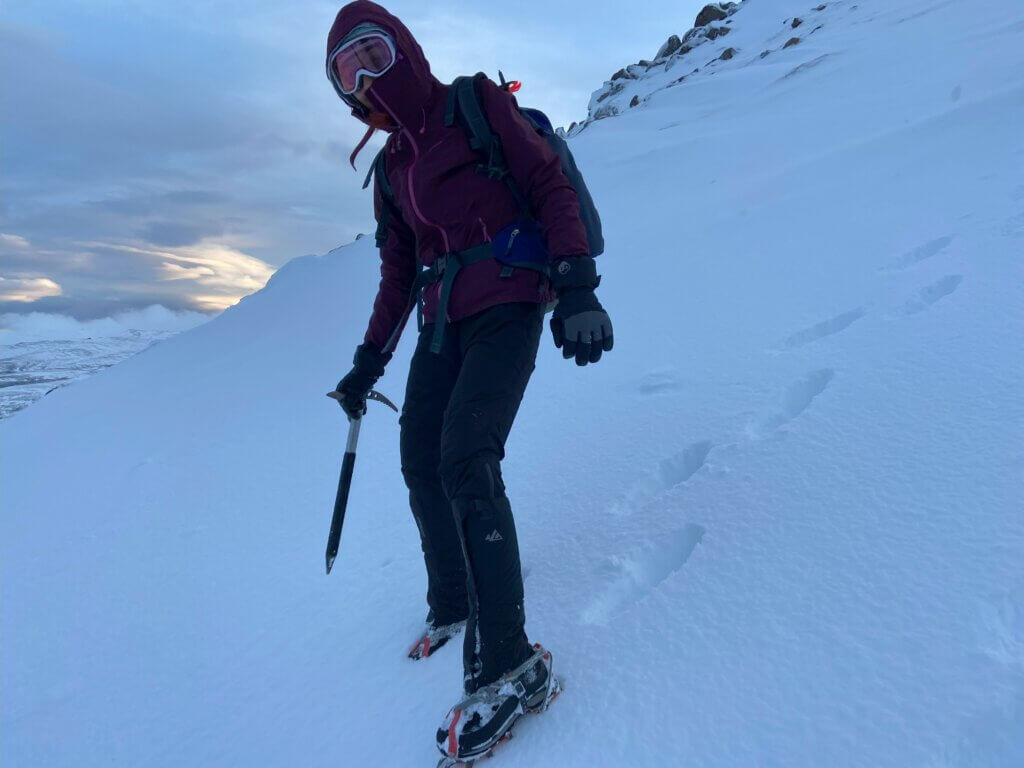
While snow is a strong likelihood on the peaks where our courses take place, there are many other elements that make your experience memorable. Thick, deep snow can sometimes make routes more strenuous. On the other hand, mixed conditions offer a chance to practice a wide variety of essential skills, including:
These skills are just as important, if not more so, than simply walking on deep snow.
Remember, winter skills are about preparing you for all types of conditions you might encounter in the mountains. Snow is a bonus, but not a requirement. The camaraderie, expert instruction, and opportunity to immerse yourself in Scotland’s stunning winter landscape are what truly make Scot Mountain Holidays’ courses unforgettable.
So, whether the snow is thick, patchy, or concentrated in specific areas, rest assured that your Winter Skills course will still be an incredible and valuable experience. The Cairngorms’ rugged beauty, combined with expert guidance, ensures your time with us is both safe and rewarding. As one participant noted, “The course was transformational—I learned so much, regardless of snow levels.”
Join us this winter to develop your confidence and skills in one of the UK’s most dramatic settings. With Scot Mountain Holidays, you’re in expert hands, and no matter the snow conditions, we’ll make sure your time in the Cairngorms is unforgettable.
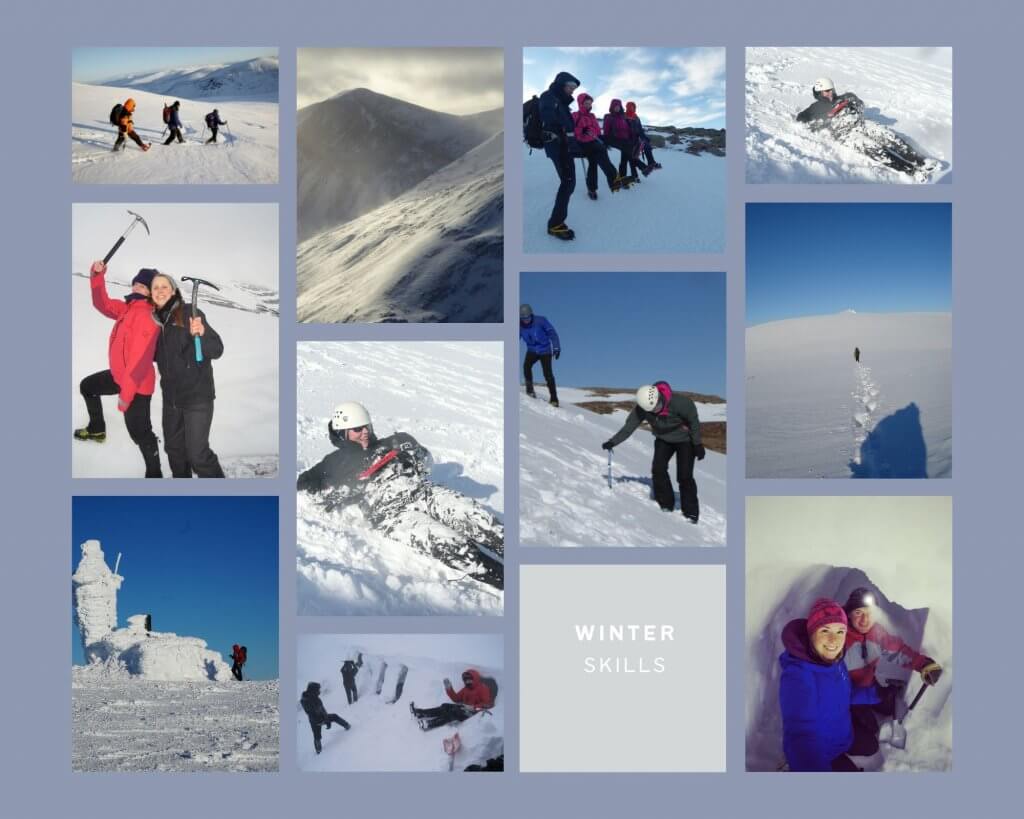
Scotland is a land of breathtaking beauty, with unique charms that shift with the seasons. While summer often steals the spotlight for visitors, winter remains a hidden gem offering raw beauty, crisp days, and unparalleled hiking experiences. If you’ve been hesitant to venture out during the colder months, let us convince you with five compelling reasons to go hiking in winter and join Scot Mountain Holidays for a trip you’ll never forget.
The peaks of Scotland are awe-inspiring at any time of year, but winter elevates their majesty to a whole new level. Snow-dusted summits, frost-kissed landscapes, and the clarity of winter skies combine to create an otherworldly spectacle. On clear days, the views are nothing short of magical, with the crisp air enhancing visibility and making every vista unforgettable. Scotland’s Cairngorms, for instance, often boast snow-covered peaks that rival the beauty of alpine ranges. Layer up, embrace the brisk wind, and let the beauty of hiking in winter reward your efforts.
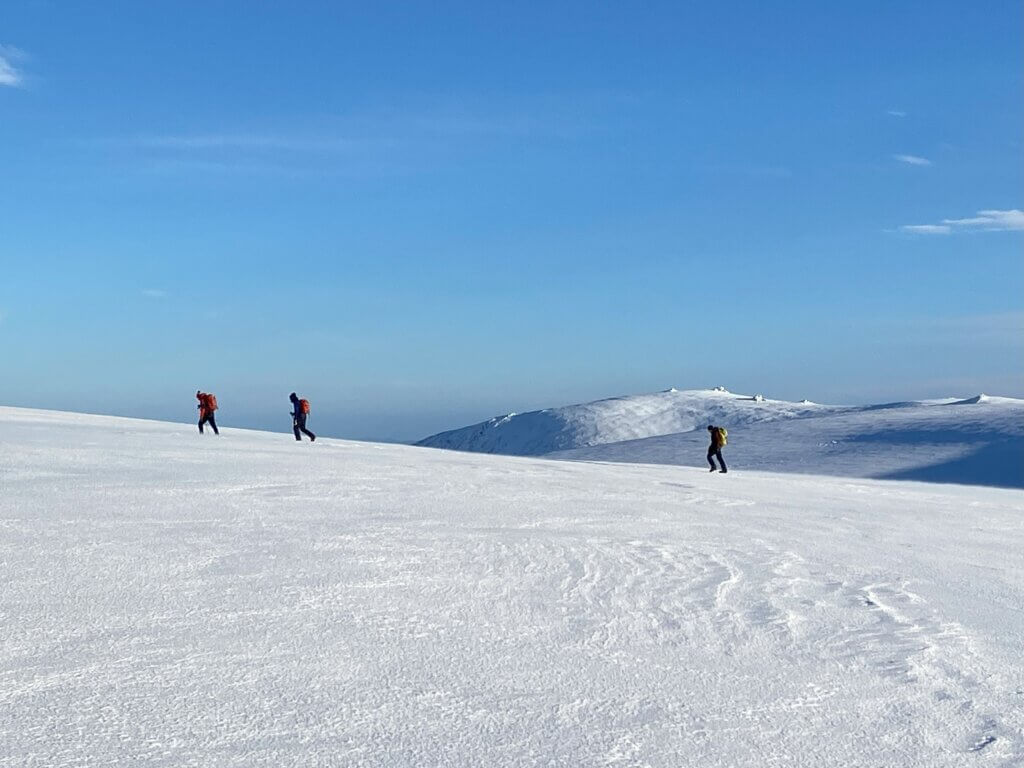
What a view! – New Year Winter Walking 2022 – 2023
The cold temperatures of winter naturally deter many would-be hikers, leaving the trails quieter and more serene. This means fewer crowds and more opportunities to immerse yourself in the solitude of Scotland’s wild spaces. With fewer distractions, you can fully connect with nature, reflect, and appreciate the tranquility of your surroundings. Imagine having iconic trails, like those in the Cairngorms or around Ben Nevis, almost entirely to yourself. It’s an unparalleled chance to experience Scotland’s rugged beauty in its purest form while hiking in winter.
Winter unveils a strikingly different perspective of Scotland’s landscapes. The absence of lush greenery exposes the raw, rugged beauty of the mountains—from dramatic rock formations to stark, snow-covered terrain. If you’re lucky enough to encounter fresh snowfall, the transformation is magical. The pristine white blanket enhances the contours and textures of the land, offering photographers and nature enthusiasts endless inspiration during their winter hikes. Plus, winter often brings incredible sunrises and sunsets that bathe the snow-dusted peaks in hues of gold and pink, perfect for unforgettable photos.
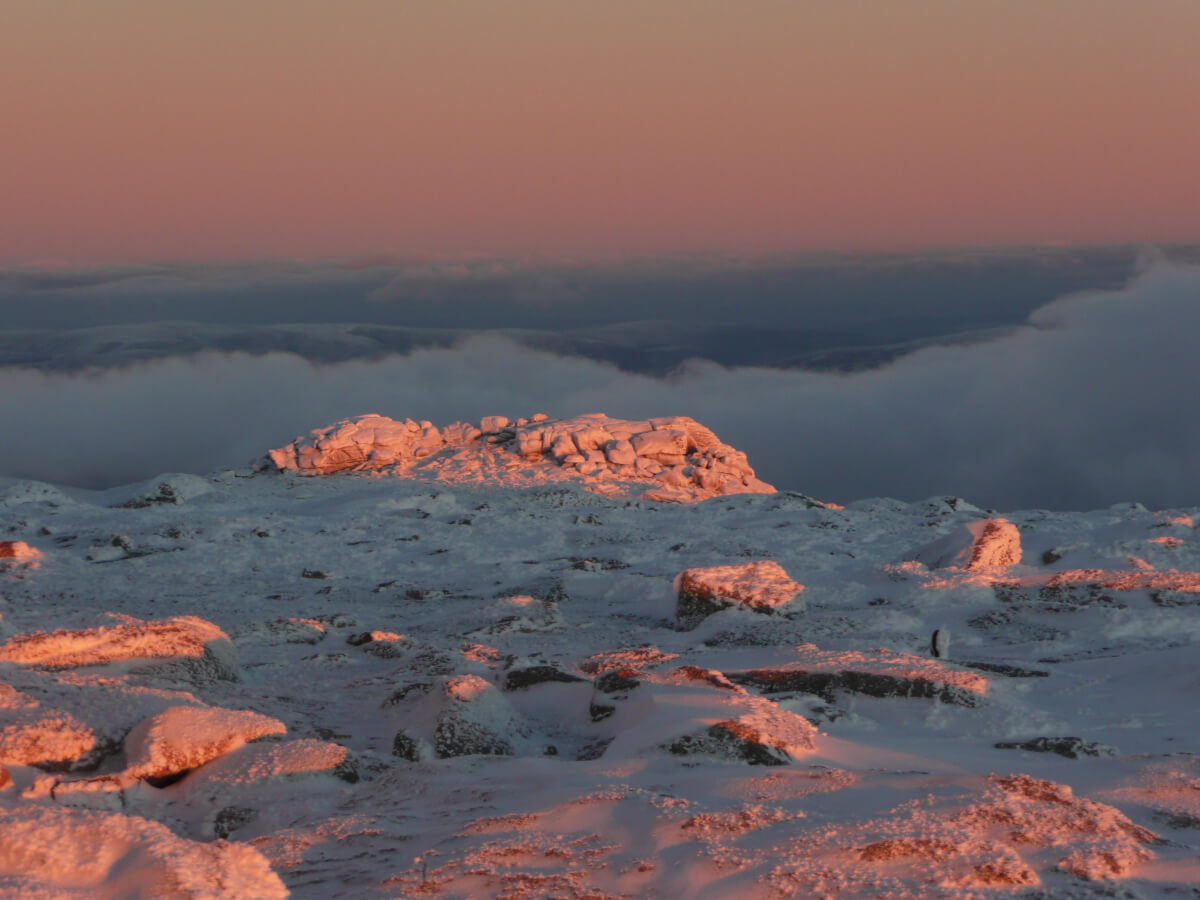
Winter sunset colours glowing on the snow covered Cairngorms
For the fitness-minded adventurer, hiking in winter provides an added bonus: increased calorie burn. The colder temperatures force your body to work harder to stay warm, meaning you’ll burn more calories compared to hiking in warmer weather. Add in the effort of navigating snow-covered paths, and your winter hike becomes an even more rewarding workout. Studies suggest that cold-weather exercise can burn up to 30% more calories, making winter hikes both invigorating and beneficial for your health.
Hiking in winter introduces unique challenges, from navigating icy trails to managing colder temperatures. These added elements demand a different level of preparation and skill, but they also offer an unparalleled sense of achievement. Conquering a winter hike builds confidence and leaves you with stories to share for years to come. Proper preparation—like wearing crampons and layering effectively—can transform these challenges into exciting opportunities to learn new skills. Plus, the sense of adventure and novelty makes every step more exciting.
If you’re ready to challenge yourself, embrace the season, and experience some of the most stunning terrain and views imaginable, hiking in winter in Scotland awaits. With the Cairngorms averaging over 100 days of snow cover per year, it’s one of the best places in the UK to experience a true winter wonderland. Join Scot Mountain Holidays for a guided adventure that will leave you with lasting memories and a newfound appreciation for this extraordinary season.
Setting off on expedition across the snowy Cairngorm plateau
When you think of snow, it’s easy to picture adrenaline-filled days of skiing or snowboarding. But what if you’re not a fan of the slopes or simply want to try something different? Scotland offers a winter wonderland full of thrilling alternatives that let you embrace the snow in unique ways.
Here are Scot Mountain Holidays’ top four snowy adventures for non-skiers, perfect for creating magical winter memories.
Hiking isn’t just a summer activity—winter hiking offers a whole new level of magic. With snow-dusted trails and tranquil, crowd-free paths, it’s the perfect way to experience Scotland’s rugged beauty in its most serene form.
Yes, winter hiking comes with challenges, but the rewards are extraordinary. Picture yourself surrounded by glistening peaks, breathing in crisp mountain air, and savoring the quiet that only snow can bring. Just be sure to bundle up and prepare for the elements!
For those craving adventure with a side of learning, Scot Mountain Holidays offers snow skills courses that are as practical as they are exhilarating.
From mastering ice axes to building emergency snow shelters or navigating icy terrain, these courses give you hands-on experience that’s both empowering and fun. Not only will you leave with stories to tell, but you’ll also pick up life-saving skills that every winter enthusiast should have.
Not every snowy adventure needs to be a grand expedition! Sometimes, the best memories come from simple, joyful moments.
Spend an afternoon building a snowman, crafting the perfect snow angel, or engaging in a good old-fashioned snowball fight. If you’re traveling with kids (or just feeling like one yourself), grab a sled and race down a snowy hill.
End your day by cozying up by a roaring fire with a hot drink and a good book. After all, there’s nothing like the warmth of home after a day of snowy fun.
If you’ve never tried snowshoeing, you’re in for a treat! Imagine strapping on tennis racket-like footwear and gliding effortlessly across snowy trails and frozen terrain. Snowshoeing is easy to learn, beginner-friendly, and a fantastic way to immerse yourself in Scotland’s breathtaking winter scenery. However, the snow conditions on the Scottish hills are not always suitable for snowshoeing which lends itself more to the soft powder snow you find in the Rockies or the Alps. It’s far more common to see winter hikers in Scotland out with crampons and an ice axe, than it is to see a group of snowshoers.
From snow-covered peaks to quiet, magical trails, Scotland is the ultimate destination for winter lovers. With Scot Mountain Holidays, you can enjoy a range of activities designed for adventurers who want to experience the snow without strapping on skis or a snowboard.
So, whether you’re trekking through glistening forests, learning new skills, or simply playing in the snow, Scotland promises a winter escape like no other.
Ready to trade the slopes for something different? Let Scot Mountain Holidays help you craft your perfect snow-filled adventure!
Andy Bateman of Scot Mountain Holidays leads at least 3 commercial snow hole expeditions in the Cairngorms Mountains every winter season. He has introduced scores of people to the magic of the winter season. He is also an expert at the skill of building a snow hole for a drip free night out in the mountains. To see what snowholing expedition experience is like for the customer check out our video on YouTube:
Seasonal temperatures on the high hills in Scotland are never as low as those in the valleys. You need to take this into consideration when planning to snowhole. Here in Boat of Garten we get temperatures of around -20oC. The lowest ever recorded temperature on the summit of Cairngorm is -16.5oC. Cold temperatures in the valley always occur under cold settled conditions. This is when the cold air drains off the mountain. The cold air then pools in the bottom of the valley. This means that in the Cairngorms the temperatures are never as low as in Norway.
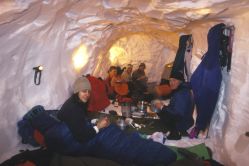
Enjoying an evening meal in the luxury palace makes the snowholing expedition unforgettable!
In Norway, you need to capture the warm air. Most people learn to build snow caves in Norway. They learn to create features which capture the warm air inside the shelter. In Scotland, however, you are operating much close to the melting temperature of snow so sloping entrances, sleeping platforms and cold air drains become much less important for the snow hole expedition.
Roof sag is a combination of the temperature rising too much, poor ventilation and not having a thick enough roof or having a large area of unsupported roof. A roof and front wall of approx. 1m thick is vital. If daylight can be seen through either the roof or the wall, they are probably too thin. However, bear in mind that a roof that thick will need an adequately thick & strong front wall.
Avoid large areas of unsupported roof by keeping your snow hole more like a tunnel, narrow. Aim for a distance of no more than 2 body widths, side by side lengthwise. This means you can create a steep-angled apex ceiling which helps to avoid any drip points and allows you to channel warm air towards ventilation holes.
Many snowhole sites by virtue of their high snow accumulation and steep slopes are prone to avalanches. To be safe, you may need to pick a slope with a more gentle gradient and spend more time digging into the slope. To maintain a 1m thick roof on a 30 degree slope you will have to dig horizontally 2m from the top of the doorway before widening out.
Make sure there is good ventilation and regularly watch your breath then you will avoid carbon monoxide poisoning. If you see it drifting off to one side, it’s a good indication that ventilation is adequate. Never cook in a snowhole without regularly checking there is adequate ventilation.
It’s a good idea to create ventilation holes in your snow hole because of the Scottish climatic conditions.
Make your snow hole large enough to stand up in so you don’t get back ache from crouching.
One potential hazard of digging a small snow hole is that you don’t have enough space to put the snow when you attempt to extricate yourself in the morning. One of the snowholes Andy built in the Cairngorms involved digging out through 1.5m of fresh, drifted snow to get out in the morning.
Never underestimate how hard the Scottish snow pack could be. At least make sure your snow shovel has a metal scoop and that you are also carrying a snow saw.
Time taken to construct your snow hole is vital. A communal snow hole can take 4 – 5 hours to dig to make sure that you have the best construction possible.
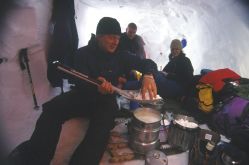
See more about our snow hole expedition!
Winter is when the Scottish hills mutate into proper mountains which need as much respect as 8000m peaks in the Himalayas. Every year there are reports of people going missing or dying in the Scottish hills. Though most people don’t realise it, it is relatively common for avalanches to go off in Scotland as well as in the Alps. Anywhere you find snow and steep slopes, there could be avalanches. Before you consider going out in winter you do need to be aware of the additional hazards and take them into consideration when making your plans. It is sensible to think of booking a winter walking guide.
If you are thinking about starting some winter walking it is extremely important to make sure you get some safety training. There are always deaths in the hills in winter. Safety training is not a guarantee that you will never have an accident but it does minimise the risk. It is important to realise though that as with all skills, you must practise. If you don’t, then the skill won’t be useful to you. For example:
on a winter skills course in the UK you are always taught “ice axe arrest” as one of the skills you will need to prevent a sliding fall. Can you imagine slipping on ice on a mountainside? The speed you achieve in a very short space of time will amaze you. Reaching for your ice axe and using it the correct way, needs to be instinctive. This takes practise as does assessing snow and ice conditions and knowing the local terrain.
Planning to go out winter walking? You’ll need to book a skills course or a guide to make a start.
Qualifications to look for:
If you are considering hiring a guide/leader you need to make sure that they have one of the following qualifications:
Winter Mountain Leader (WML) – lead groups of hill walkers in winter conditions
Mountaineering Instructor Certificate (MIC) – instructing the skills of snow and ice climbing
British Mountain Guide (BMG) – required to guide climbing (including the coaching of lead climbing) skiing and mountaineering on rock, snow & ice, and in alpine terrain
Unless you are yourself, considering leading groups in the winter mountains, there is no need to go to the extent of committing yourself to this level of training. The courses take a commitment of months or years and previous training. For pleasure, you would only need to consider a winter skills course or winter mountaineering course, which can be provided by the above instructors.
A skills course is not the solution for everyone. After all, just learning the technical skills is not the learning journey, you still need to know how to deal with the added challenge of navigating in winter. Many people prefer the security of taking a winter walking guide because of the added challenges of the winter weather.
Scot Mountain Holidays delivers a series of winter walking holidays, expeditions and challenges. We can also arrange a private winter walking guide for you (and your group) if you are unable to join an organised group.
New Year Winter Walking – Classic Winter Cairngorms – Winter Munros – Glencoe Munros –
Snow Hole Expedition – Cairngorm 4000ers – Winter Affric Shangri La – Knoydart Winter Wilderness Expedition –
The main difference between our 2 winter skills courses is that there is not enough time on the 2 day course to cover the essential skill of winter navigation. We do run a separate winter navigation course over 2 days.
2 day winter skills course – 5 day winter skills course
If our dates or our format doesn’t suit you please use our directory below to find a course or holiday which suits your requirements
Across Scotland – CnDo Scotland or Wilderness Scotland
In the Cairngorms – Talisman Mountaineering or Tarmachan Mountaineering or Cairngorm Treks or Cairngorm Adventure Guides
On the west coast – West Coast Mountain Guides or Martin Moran guiding or Abacus Mountain Guides
Words of wisdom from the Met Office and the BMC.
Our instructors:
Andy Bateman, our company director, is the main guide for Scot Mountain Holidays. He is a qualified winter mountain leader with 15 years experience instructing in the Cairngorms. He says there is nothing like local knowledge for being aware of the avalanche hotspots and how to avoid them. He keeps a very close eye on the weather from this time of year (November) until winter passes towards the end of April and is out on the snowpack so frequently that he has almost as good an eye for predicting the avalanche weaknesses as the SAIS team.
We also work with experienced mountain instructors who deliver mountaineering and climbing courses for us. The instructors live in the area and have in many cases instructed for the RAF outdoor centres when they were based in Grantown on Spey. All instructors who work for us have a wealth of local knowledge.
Winter courses offered by Scot Mountain Holidays
It is essential if you are planning to go out in the hills on your own or even with a small group of friends that you should all have had some formal training in personal safety skills so you know how to use your crampons & ice axe effectively and have all the gear necessary. Navigation is perhaps the least valued of these skills, but arguably the most valuable. We also offer training in winter navigation techniques.
Winter holidays offered by Scot Mountain Holidays (including expeditions)
If you would like to get out in the winter but are not confident of managing on your own, you might want to join an organised group. Take a look at our dates and see if we have anything which will suit your commitments.
USEFUL LINKS
Mountain Weather Information Service
Scottish Avalanche Information Service
So you’re planning a high overnight camp and you’re wondering how warm your winter sleeping bag should be?
Likely Ambient Temperature
With a number of recent TV documentaries ‘laying it on a bit thick’ about how low the temperature can drop in Scotland’s Cairngorm Mountains you might be forgiven for thinking you were heading for somewhere akin to the high Arctic! Indeed the temperature in the Scottish Highlands has been recorded approaching -30 deg C (-27.2 to be precise – the official British record) but this has only been on three occasions in 120 years!
Interestingly, Cairngorm summit (1245m) has only ever managed a record minimum of around half of this at – 16.5 deg C (12th Jan 1987) whilst the residents of nearby Nethybridge (210m) at the foot of the mountain claimed the mercury dropped to -31.3 deg C on 10thJanuary 1982, the same night as one of the -27.2’s was recorded. Satellite evidence suggests they were right!
The vital bit of missing information on these – 30ish lows are that they’ve all been recorded as a result of temperature inversions. That is, cold air has flowed off the mountains and pooled in the valley bottoms where it’s cooled further whilst the mountain summits have remained appreciably warmer. These record minima are in no way a reflection of the likely temperature you would find on our mountains, possibly not surprising considering all our mountains are never that far from a relatively warm sea.
So what would be the likely temperature at the main snow-hole sites, let’s say, in the Cairngorms at around 1100m? Well, the seasonal minimum for 900m is usually around -8 deg C which could, at a pinch, translate to -10 deg C at 1100m but far more often in winter it’s around minus 5 and above. The point is, on our mountains we don’t experience anything like the temperatures you might get in e.g.Norway.
Be guided by advice of sales staff in the shop who should have some relevant experience. Ask for shop expert if your sales person doesn’t demonstrate sufficient knowledge of the range on sale.
Most importatly – buy quality for a sleeping mat. In winter, it is most important to make sure you are insulated from the snow beneath you as you’ll lose the majority of your bodyheat this way.
It goes without saying of course you need to be checking the weather forecasts before you head out. A tented high camp in winter needs to be carefully judged. Those who have got it wrong have ended up having their tent destroyed and gear being scatted far and wide by hurricane force winds.
Andy Bateman 14/11/14
USEFUL LINKS
Mountain Weather Information Service
Scottish Avalanche Information Service
A taster of winter skills, but the only way to really learn how to ice axe arrest is to do it yourself under the guidance of a winter mountain leader or other qualified instructor. Imagine taking a tablet or smartphone out in the snow to try and teach yourself … pretty much a lost cause at the end of the day and you’d be terrified of smashing your technology to pieces. Bit the bullet and book a course.
We found this video on YouTube, produced by the MCofS. Here Roger Wild introduces ice axe arrest and explains the basics which you’d learn on the hill with Andy (lead instructor with Scot Mountain Holidays). If you’re comtemplating a winter skills weekend, bear in mind that this is one of the core skills you’ll be learning, which many people have heard about before they book a skills weekend; however, as Roger Wild says: there’s a lot more to the full range of skills to keep you safe in winter and you should consider ice axe arrest to be the last in a series of skills aimed at preventing a sliding fall.
Check out our Top Ten Winter Skills tips: https://scotmountainholidays.com/blog/top-10-winter-skills-tips/
(A synopsis in pictures)
The snow’s back here in the Cairngorms and it’s only 4th November 2014 – plenty of time for the snow to build up for a fabulous Christmas and New Year in the Highlands. Take a look at our selection of winter images below – all taken in during winter seasons in the Cairngorms. Will it be an official white Christmas or just white on the high peaks of the Cairngorms
Photo caption: A day out in the snow – heading home in the sunset,
turning the snow pink and giving life to the Cairngorms –
also known as Mhonaidh Ruaidh (the red hills).
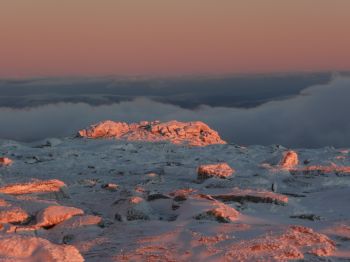
Photo caption: Sometimes a wee bit of cloud can play into your hands
and produce a much more stunning picture than a clear blue sky,
especially in the soft winter light we get here in the Cairngorms,
which is of course enhanced by reflection on the snow.
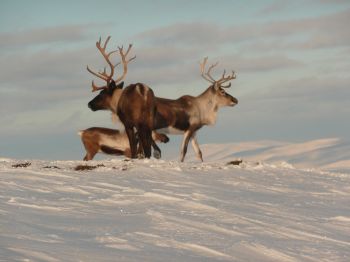
Photo caption: Unique to the Cairngorms National Park,
Britain’s only reindeer herd, which are free-roaming
across the hills in the winter. You could bump into them
on any of our courses or winter walking holidays.
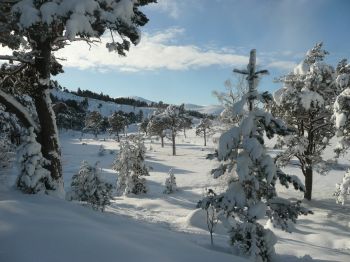
Photo caption: White Christmas? Wouldn’t that be amazing?
This is the kind of snow laden scene
we’d all like to see, but how many of you would like to
experience it yourselves? When the snow lay round about,
deep and crisp and even …
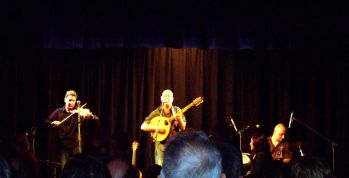
Photo caption: It’s New Year and it’s Scotland – must mean it’s time for a party –
or as you’re in Scotland let’s give it the proper name and join the ceilidh!
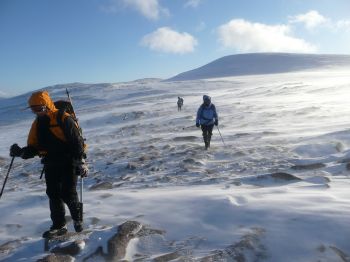
Photo caption: Winter walking holiday across the Cairngorm plateau. Check out the blue skies!
Inspired? Check out some of our winter offerings in the Cairngorms and further afield across the Highlands of Scotland
All content © Copyright Scot Mountain Holidays 2025
Responsive web design by Summit Web Solutions